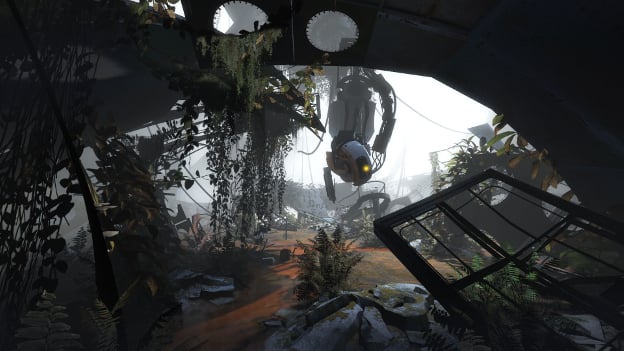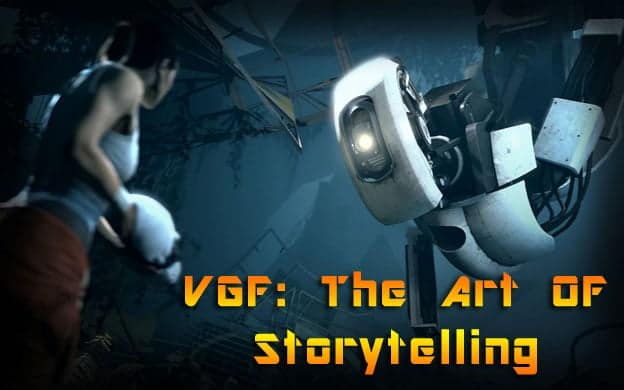VGF: Portal, Left 4 Dead, And The Art Of Storytelling
Someone once told me that they felt that Portal had absolutely no story. This struck me as particularly odd, because I see a lot of Valve’s games as landmarks in video game storytelling, and the Portal games are among the strongest examples.
Now, I’m going to delve a little bit into fiction writing 101 here, but I promise I’ll keep it simple and brief. There is one essential element in storytelling: conflict. Anything else—character, dialogue, action, environment, etc.—is merely the window dressing. The context for the conflict, if you will. Surely you can have conflict without story, but you simply cannot have story without conflict. So the first thing you should look for when trying to determine if something is a story is to ask yourself whether or not there’s conflict involved.
Does Portal have conflict? Absolutely. Not only does it tell the story of Chell versus GLaDOS, but there’s the more subtle conflict of the gameplay itself, which pits the portal gun against the environment. This conflict is introduced toward the beginning, then rises to a climax with the GLaDOS boss fight, after which there’s a brief cinematic. Now, what I’ve just laid out for you—conflict introduced, rising action, climax, falling action—is the basic skeleton of any story.
So does Portal have a story? It certainly does. Your English teacher would agree with me.
But let’s look at another Valve game, one that is much more commonly labeled as having no story whatsoever: Left 4 Dead. Does Left 4 Dead tell a story? Well, first of all, does it have conflict? Of course. Four survivors versus hordes of zombies. The most important element of storytelling is here and accounted for. But what about all that rising action and climax business? Well, the general skeleton of each of L4D’s chapters could be laid out like this: four survivors are introduced and thrown into a zombie-filled city (conflict introduced), they fight their way toward a particular goal (rising action), and the end of the mission has you defending yourself against an ungodly amount of zombies (climax) until your means of rescue shows up (very brief falling action).

Now, here’s a fact that most people who play Left 4 Dead are completely oblivious to: Left 4 Dead is completely overflowing with side stories, and this is where the real depth of the L4D plot can be found. If you’ve ever actually made it to a safe room (as I’m sure you have if you aren’t a complete noob or a rage-quitter), you’ll know that the insides of these rooms are filled with graffiti from past survivors. A good portion of Left 4 Dead’s story is written on walls. In these scribbles you’ll find pleas from survivors begging for help, laments over countless loved ones lost, brief glimpses of hope that there might be an escape, and, of course, the complete and utter hopelessness of those ready to give up and spend one last bullet ending their own sorry existence. These stories range from the profound and moving to the absurd, silly, and sarcastic.
In the L4D games, digging into the story is completely left up to the players. If you want to mindlessly slaughter hordes of undead with three friends, go ahead. If you want to explore the fragments of a dying world, piecing together the sad intertwining tales of those who have lived (and died) through this horror, then there’s a lot for you to look at.
The key to L4D’s storytelling is its subtlety. Now, a man named Ernest Hemingway once claimed that in writing a story, you should only give your readers as much information as they absolutely need, letting them piece together the rest on their own. He compared it to an iceburg; most of an iceburg is underwater, and from a ship, you’ll only see about ten percent of it. (This type of writing has since been dubbed the Iceburg Theory.)
Now, whether or not you’re harboring deep bitterness toward Mr. Hemingway because you were forced to read The Old Man and the Sea at a time when your young mind was simply too small to process its profound layers of depth, you have to admit that this guy was important. Your English teacher will tell you he’s important, anyway. Unless your English teacher is a moron.
This Hemingway fellow illustrated his point with this six-word story: “For sale: baby shoes, never worn.” Yes, those six words tell an entire story. What is the conflict? Well, we actually aren’t concretely given that information. But it’s hinted at. What we learn from these six words is that a woman was planning on having a baby, bought shoes, and it turned out she wouldn’t be having the baby after all. What happened to the child? Was it aborted? Miscarried? Perhaps a false positive on an early pregnancy test? Whatever happened, we can assume it was heartbreaking for this woman, as buying baby clothes implies that she had every intention of carrying the child to term. These six words paint a tragic story of the loss of something that should have come into being, yet never did. Perhaps the conflict here is that of this woman versus the sad truth of this whole thing. Life versus tragedy.
The walls of L4D’s safe houses give us dozens of these tip-of-the-iceburg-type stories.
I think this is where my befuddled friend missed the point; there are several possible ways to tell a story. Valve tends to litter its games with these sorts of “optional” storylines. For example, in Half-Life 2, you’ll find several elements littered about the environment that build the Half-Life mythos. I remember one scene in particular where you find a television set left on. If you want to, you can sit and watch this entire news broadcast that gives you quite a bit of info on what’s going on in the world around you. (Note: this is absolutely not a cutscene.) If you don’t want to sit through the broadcast, you can move on and leave the television blabbering. In fact, you can even put a bullet through the screen and shut it up once and for all.

I say all of this to illustrate one thing: video games have the potential to tell stories in ways that would be impossible, or at least very difficult, in any other type of media. Left 4 Dead’s “stories written on the walls” approach isn’t exactly unique to video games, as many comic books experiment with subtler background stories like these. (Alan Moore, in particular, tends to work with artists who work these types of details into the stories. Watchmen and V for Vendetta are great examples.) Yet video games have a lot more leg room when it comes to presenting a story this way because of their interactivity. It’s one thing to slap some graffiti on a wall in a comic book panel, but allowing people to explore game worlds and find these things for themselves, like the hidden Rat Man rooms in Portal 2, is a vast extension of this idea.
My prediction: Video game storytelling is still evolving. I think more and more we’re going to see new and interesting techniques that wouldn’t be possible in a movie or a book. The graffiti in Left 4 Dead and Portal provides just one example of the type of stories games can tell that would be fairly difficult to pull off in any other form of media.
But this week we’ve barely scratched the surface. Storytelling is an aspect of gaming that is still very much evolving, and I’d like to take a closer look at that evolution. Next week, I’ll do just that. See you then.
By Josh Wirtanen
CCC Editor/Contributing Writer
*The views expressed within this article are solely the opinion of the author and do not express the views held by Cheat Code Central.*
